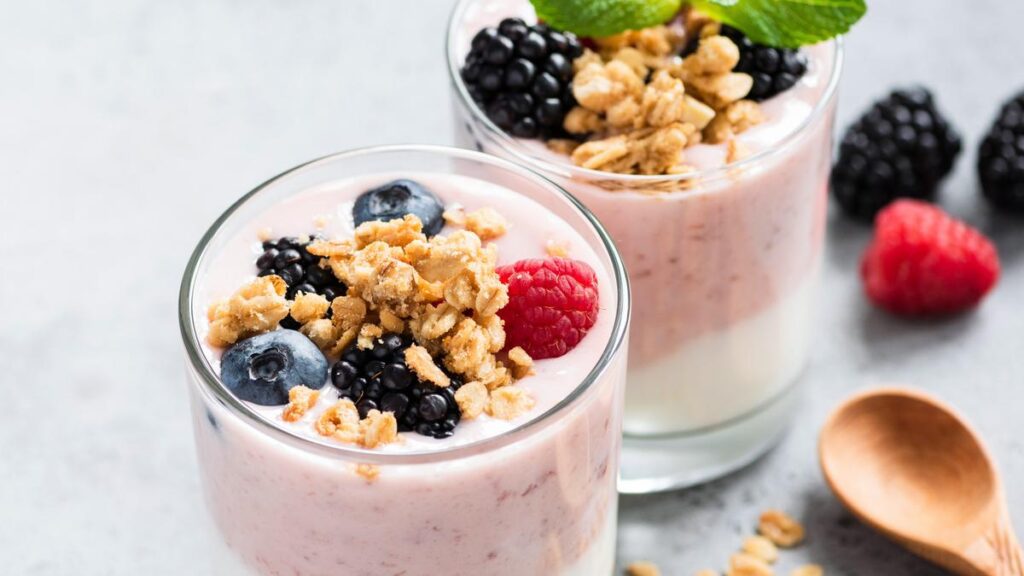
Healthy Breakfast Food Yogurt With Berries, Granola. Clean eating, Healthy eating, Vegan or Vegetarian diet concept.
Recent discussions around weight loss have increasingly focused on Glucagon-like peptide-1, or GLP-1, a hormone that helps regulate appetite and blood sugar levels. While many are familiar with GLP-1 injections, health experts now emphasize that certain foods can naturally stimulate the body’s production of this hormone, potentially aiding in weight management and overall metabolic health.
GLP-1 is secreted by intestinal L-cells in response to food intake. This hormone plays a crucial role by stimulating insulin secretion, suppressing glucagon, and slowing gastric emptying, which collectively enhance feelings of fullness. Foods that trigger GLP-1 release include proteins, healthy fats, and dietary fiber.
Key Foods for Stimulating GLP-1
Among the best protein sources are eggs, fish, and yogurt. Eggs, noted for their versatility and affordability, are especially effective in promoting GLP-1 secretion. They are high in protein, which helps reduce post-meal glucose levels and prolongs satiety compared to carbohydrate-heavy meals.
Fatty fish, such as sardines, salmon, and mackerel, are rich in omega-3 fatty acids and high-quality protein. Regular consumption of these fish can enhance GLP-1 release while offering anti-inflammatory benefits. Experts recommend including fatty fish in your diet at least three times a week.
Nuts and seeds also contribute positively to GLP-1 levels. The combination of healthy fats, protein, and fiber in these snacks helps slow gastric emptying and improve insulin sensitivity. For instance, snacking on cashews can help maintain feelings of fullness.
Another beneficial addition to meals is extra virgin olive oil, which contains monounsaturated fats that stimulate GLP-1 more effectively than saturated fats. Incorporating olive oil into daily meals can aid in achieving better insulin sensitivity and managing glucose spikes.
Vegetables, particularly those high in fiber, such as broccoli, Brussels sprouts, carrots, and artichokes, also support GLP-1 secretion. Research indicates that consuming vegetables before carbohydrate-rich foods can enhance their effects on GLP-1 and glucose regulation. Aiming for at least five servings of vegetables per day is recommended for optimal health.
The Role of Fermented Foods and Eating Habits
Fermented foods contribute to GLP-1 secretion as well. Starting the day with yogurt, enjoying a cup of miso soup, or adding kombucha and sauerkraut to meals can significantly enhance gut health and GLP-1 levels.
When constructing meals, focusing on a combination of protein sources, such as dairy, chicken, tofu, or fish, alongside fiber-rich carbohydrates can yield better GLP-1 responses. The Mediterranean diet, which emphasizes nuts, fish, legumes, vegetables, and olive oil, has been shown to effectively boost GLP-1 and overall metabolic health.
One practical tip for enhancing GLP-1 secretion is to slow down and enjoy meals. Chewing thoroughly can contribute to greater hormone release and improve digestion. Simple changes to daily eating habits, such as incorporating Greek yogurt with nuts and berries for breakfast, snacking on nuts, or adding avocado and beans to salads, can facilitate natural weight management.
As the conversation around weight loss continues to evolve, understanding the impact of specific foods on GLP-1 secretion opens new avenues for managing appetite and metabolic health without reliance on injections. By making informed dietary choices, individuals can harness the power of nutrition to enhance their well-being.






